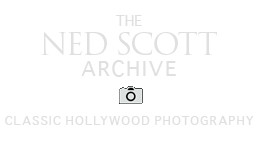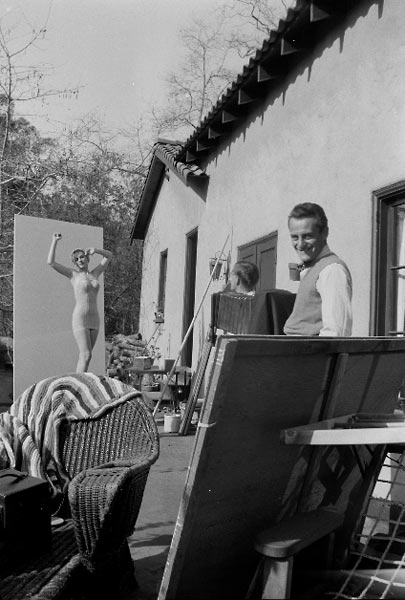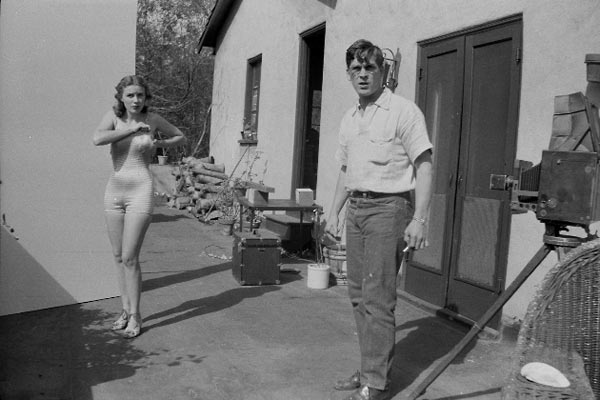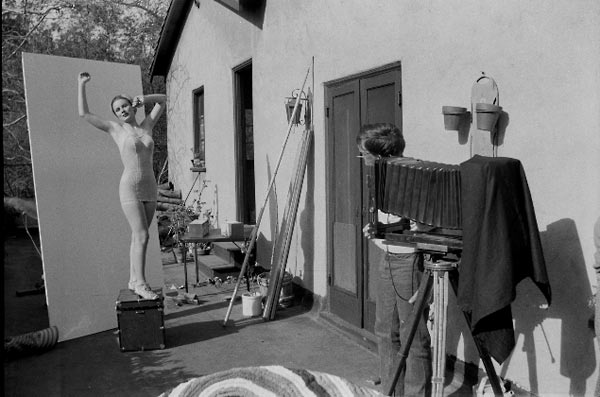Gantner & Mattern Co. |
|
Ned Scott had joined the ranks of Hollywood still photographers in 1935 after returning from his first film assignment, Redes/The Wave, in Mexico with Paul Strand as producer. His movie assignments were productive but scattered at first, and he sought to supplement his income with commercial assignments wherever possible. No doubt his largest and longest assignment involved advertising photography for the Gantner and Mattern Co., clothing manufacturers in San Francisco. Their chief clothing lines were sweaters and sportswear. This association lasted from 1937 through 1942. Ned Scott approached this assignment with keen professionalism born of his training with the Camera Club of New York and his experience with early film assignments in Hollywood. His behavior in support of Gantner & Mattern’s photographic assignments went far beyond what is professionally correct in the commercial photo environment found today. Gantner & Mattern expected him to find suitable sweater and swimwear models from the local area around Los Angeles. These models had to be approved by Miss Edith Skemp, chief of the Advertising Department at G & M. Scott paid these models out of his own pocket, and then G & M reimbursed him for those costs. All photograph settings were outdoor venues, presenting challenges to the photographer which are not present in a controlled studio atmosphere. Ned Scott chose all backgrounds and props on his own with little guidance from Miss Skemp. This process led to disputes and misunderstandings, some quite colorful and amusing. Finished photographic prints of acceptable quality and style were accomplished after numerous steps including photo processing, proofing and approval, retakes if necessary and finally, retouching where needed. The bulk of correspondence between Miss Skemp in San Francisco and Ned Scott in Santa Monica went through the U.S. Post Office Department resources, and this included all letters, packages of clothing items, photo proofs for model approval and ad images and lastly, the finished prints. Railway Express and Parcel Post services were also utilized. Time was of the essence in mailing and this need often required the use of special delivery service, a quality service, by the way, which has completely disappeared from the postal scene today. Reading these letters which chronicle the business relationship with a major clothing manufacturer will give the researcher a sense of the scope of the work involved and the depth of Ned Scott’s commitment to that relationship. All dollar figures mentioned in these letters may be multiplied by a factor of 15 to get a sense of the monetary worth of the work performed in 2010 dollars. |
| Gantner Mattern & Co. Photography Letters |
| Gantner and Mattern Co. Photographs |
Letters – 1937 |
| The association with Gantner and Mattern began around mid year with these two letters. Ned Scott’s good friend, Vallejo Gantner, had paved the way for the development of this relationship. Being the youngest brother in the Gantner family, Vallejo served the family business effort at the company as a designer and inventor. Ned Scott remained busy with movie assignments through the balance of the year, and he did not begin his fashion photography in earnest until the following year. Life magazine had just published Ned Scott’s photographs from the movie Redes/The Wave, and at the urging of professional friends in New York, he had sent his photographic portfolios to them for review and comment. Transcript of Letter #1: letter dated June 1, 1937 from Gantner & Mattern of 1453 Mission Street, San Francisco to Ned Scott at 479 Mesa Road, Santa Monica, California: Mr. Vallejo Gantner recently mentioned that he had had a conversation with you about photography and he suggested that possibly you might have samples which you could submit for our inspection. We do not know at what time we may have a special need for photographs, but if you work is along the lines of what we require, we should appreciate knowing it. Signed E. Skemp, Advertising Dept. Transcript of letter #2: latter dated June 18, 1937: It was very kind of Mr. Vallejo Gantner to write you of my work, and equally kind that you suggest I send samples for your inspection. The delay has been due to the fact that the bulk of the photographs which might interest you are at present in New York. I have been expecting them back momentarily, but I have only today learned that they will not be available for another week or ten days. As soon as they are returned to me I will send them on to you. Signed Ned Scott Scans of original letters |
Letters – 1938 |
| The relationship begins to take on a professional tone right away. Fully aware that his photographs were destined for the pages of Vogue, Esquire and Life and other magazines, Ned Scott brought to bear all his training and experience to date. His years at the Camera Club of New York served him well as did his long association with Paul Strand. As the year progressed, differences of opinion began to arise between Ned Scott and Edith Skemp in the Advertising Department. What characteristics served ad purposes in the eyes of Edith Skemp and what constituted a good photograph in Ned Scott’s eyes were often different features. The two parties to this relationship often found themselves at odds. Despite this struggle, fine work was created and used effectively. Transcript of Letter #1 dated February 21, 1938 from Gantner & Mattern of 1453 Mission St., San Francisco, Calif., to Ned Scott, 479 Mesa Road, Santa Monica, Calif. We were glad to receive the four shots from you, even though weather conditions did not make them all that you or we would have liked. Two of them our retoucher may be able to bring up in emphasis enough to get the contrasting values required for reproductions and so we would like to have glossy prints of the monkey suit and the girl with her hand against the tank. Although they do not represent the best possible samples of your work, they give us a very clear picture of what you could do under better atmospheric conditions. Best personal regards, Edith Skemp Transcript of Letter #2 dated March 7, 1938 from Gantner & Mattern to Ned Scott: Dear Mr. Scott: We were sorry to have to ask you to duplicate the prints, but apparently they got held up in the South somewhere, for the two sets arrived within hours of each other. As you suggested, we hall use the originals. They are retouched remarkably well, and having had the privilege of comparing hem with the rough proofs you first sent, we want to congratulate your retoucher on a beautiful job. It has not yet been decided just where we will use the picture with the plain suit, but you may be interested in the reprint of a Photoplay advertisement using that of the monkey print. If you have not yet billed us for these shots, please do so now. With the writer’s personal regards, Very Truly Yours, Edith Skemp |
Letters – 1939 |
| By the beginning of 1939 many wrinkles in the relationship with Miss Skemp, the head of the Advertising Department at Gantner & Mattern, had been smoothed and settled. Disputes concerning models, backgrounds, poses and settings (locations) for each swimsuit or sweater photograph had largely played out and Miss Skemp came to have a guarded confidence, if not a professional respect for Ned Scott’s photographic ability. Ned Scott had just finished all the photographic work for producer Walter Wanger and director John Ford on Stagecoach, a movie which was quickly capturing the attention of the nation. The Golden Gate International Exposition on Treasure Island had officially opened to the public. Ned Scott’s documentary photographs of the G.G.I.E. had caught the attention of Mr. Gantner, Sr., who found them inspiring and delightful. Characteristically generous and open, Ned Scott made and presented a full set of prints of these images to Mr Gantner who responded with delight and graciousness. With a creative spark of genius, Scott created composite photographs using these images as backgrounds for swimsuit models, and these composites found their way into the advertising program for Gantner & Mattern. After September, the European War began to assert its influence on commodity prices and Gantner & Mattern’s budget, causing anticipated difficulties in swimsuit and sweater production. |
Letters – 1940-1941 |
| Though the letters in this period are spotty and not numerous as in previous years, they reveal a continuing struggle between two points of view: the advertising concept of what an image needs to do, and the photographer’s concept of same. Ned Scott speaks eloquently about the conceptual goals of photography, and for the first and only time in writing, he speaks to the retention of imagery in the mind of the audience as being one of the highest goals of his profession. He discusses the need for excellent form in an image. |











































































































